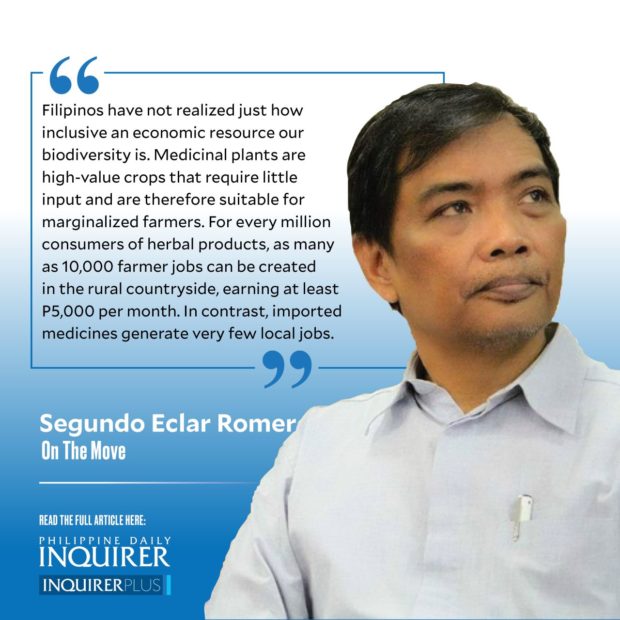
But last Friday, I felt some stirrings of hope during the 16th weekly forum of The Filipino SDG Hour, a Zoom-enabled public gathering of the Future Earth Philippines held every Friday from 4 p.m. to 5 p.m. (https://bit.ly/40c7qUd) that highlights ideas, insights, innovations, and initiatives for achieving the United Nations’ 17 Sustainable Development Goals in local communities.
Our speaker was Philip Cruz, a multiawarded scientist-entrepreneur and the president of Herbanext Laboratories, Inc., a highly successful medicinal plant manufacturer and advocate, with 100 employees based in Bago City, Negros Occidental.
Cruz told us, “Biodiversity is our single most underutilized economic resource.” Compounds from our forests and seas, he said, can be sources of novel drugs that can bring huge socioeconomic benefits to the Philippine economy, if only we realized their value and they merited protection by local governments and communities.
Sure, we’ve heard this before, how the Philippines is the center of the global center of marine biodiversity and evolution. In addition to 10,000 species of aquatic plants and animals, we have 32,000 species of terrestrial plants and animals, 60 percent of which are endemic. But our impression of this is more about how much biodiversity is poached and exploited by the more predatory countries of the world.
I sat up and listened intently when Cruz cited some statistics. He told us that two global drugs sourced from Philippine biodiversity, Ilosone (Erythromycin), launched in 1953 for treatment of bacterial infections, has annual sales of $3.2 billion, inclusive of derivatives; while Prialt (Ziconotide), derived from the seashell conus magnus (with significant contribution from the work of National Scientist Lourdes Cruz) that is 1,000 more powerful than morphine, has sales of $30 million annually.
By comparison, Cruz mentioned the relatively unimpressive annual value of our extractive industries—$3 billion from fisheries, $2 billion from mining, and $50 million from forestry. These are the industries that have caused us so much misery for decades for promising so much but delivering so little at high political and environmental costs.
Cruz said the winds have changed. There is a renaissance in the use of natural products for health and wellness. There is a slower yield from the synthetic drug pipeline, while interest in medicinal plants has increased. Only about 15 percent of the estimated 300,000 plant species worldwide have been evaluated for their pharmacological properties.
I realized just how blindsided we have been when Cruz said that China alone employs around 2 million farmers of medicinal plants, cultivating some 100 species over an area of around 460,000 hectares. India has some 150,000 medicinal herb farmers, while Indonesia has at least 20,000.
Filipinos have not realized just how inclusive an economic resource our biodiversity is. Medicinal plants are high-value crops that require little input and are therefore suitable for marginalized farmers. For every million consumers of herbal products, as many as 10,000 farmer jobs can be created in the rural countryside, earning at least P5,000 per month. In contrast, imported medicines generate very few local jobs.
The second most important realization I had from Cruz’s presentation is this: Without mainstreaming an alternative livelihood strategy, biodiversity conservation is a losing battle. The poor in rural and agricultural settings must be target beneficiaries of biodiversity cultivation and conservation programs.
Nowhere is this more urgent than for many upland and coastal communities, where the cultivation of medicinal plants can help reduce deforestation. The farming of beach forest species can help protect coastal zones and generate supplemental livelihood for fisherfolk. Adding some specific details, Cruz mentions these medicinal beach forest trees that can give protection from storm surges—alagaw, bitaog, dapdap, malabago, noni, sibukaw, sulasi.
Having listened to Cruz, I can now find new meaning in Imelda Marcos’ quip that the Philippines is a rich country pretending to be poor. Her son President Marcos Jr. is now singing a similar tune, the Philippines belonging to the VIP club of countries and being the fastest growing economy in Asia. I wonder, what would it take for him to repurpose the Maharlika Investment Fund and point it away from urban edifice complexes and toward actualizing inclusive strategic opportunities and germinating new livelihoods for Filipinos in rural and agricultural settings?
—————–doyromero@gmail.com

